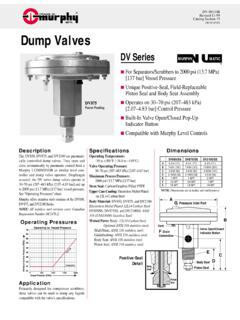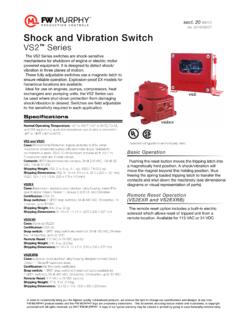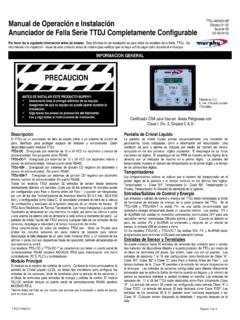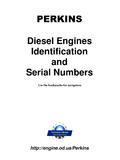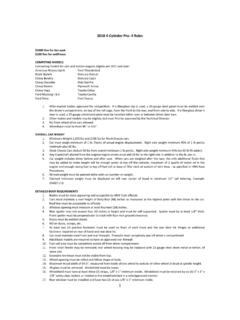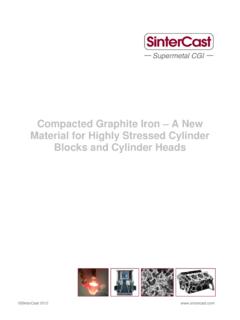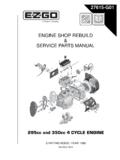Transcription of 00-02-0171 2014-03-04 Section 15 Installation …
1 00-02-0171 2014-03-04 Section 15 Installation Instructions - Level Swichgage Instruments for engine Liquids Models L150, EL150K1, and EL150EX Applications The primary use of these level Swichgage instruments is for engine cooling systems, surge or expansion tanks, condenser radiator or vapor phase systems, whether pressurized or atmospheric. These instruments can also be used to monitor lube oil, hydraulic fluid or diesel fuel reservoirs and activate alarms and/or shutdown at a predetermined minimum level. These instruments are built for low pressure systems. COLD WEATHER WARNING BEFORE FREEZING WEATHER COMES, CHECK TO BE SURE YOUR L150 OR EL150 SERIES, COOLANT LEVEL SWICHGAGE IS FILLED WITH ANTIFREEZE SOLUTION THE SAME AS YOUR engine BLOCK AND RADIATOR.
2 On many engines, such as condenser radiator systems, the coolant in your level Swichgage remains static until the level falls to drain point. When winterizing it is a good idea to make certain all water drains from your level Swichgage, to check against clogged connections, and then BE SURE IT REFILLS WITH ANTIFREEZE. FAILURE TO OBSERVE THIS PRECAUTION COULD RESULT IN EQUIPMENT DAMAGE. BEFORE BEGINNING Installation OF THIS MURPHY PRODUCT READ AND FOLLOW ALL Installation INSTRUCTIONS. A visual inspection of this product for damage during shipping is recommended before mounting.
3 It is your responsibility to have a qualified person install this unit and make sure it conforms to NEC and local codes. Disconnect all electrical power to the machine. Make sure the machine cannot operate during Installation . Follow all safety warnings of the machine manufacturer. Please contact Enovation Controls immediately if you have any questions. CAUTION: Certain danger to human and to equipment such as applied in a mobile or marine application may occur if some equipment is stopped without pre-warning. It is therefore recommended that monitored functions be limited to alarm only or to alarm before shutdown in such applications.
4 -2- Dimensions Installation Instructions PS Fittings Installation A Murphy PS fitting is used when there is no threaded fitting in the top tank of the radiator to attach tubing for the L150/EL150 series level Swichgage instrument. P/N 15-00-0107 (PS) Accepts 1/4 in. (6mm) copper tubing. P/N 15-01-0167 (PS Barbed) Barbed fitting accepts 1/4 in. (6mm) flexible tubing and hose clamp. P/N 15-01-0202 (PS-D) Accepts 1/2 in. (13mm) hose; 1/4 in. (6mm) copper tube. 1. Determine the entry point into the radiator top tank. See Level Swichgage Instrument Installation for proper location.
5 Drill 1/8 in. (16mm) diameter hole in top tank of radiator. Be sure chips do not fall inside the tank. Remove any burrs on the hole wall. 2. Insert the rubber grommet of the PS Fitting. Tighten the jam nut while holding the fitting from turning in the hole. The jam nut will pull the tapered grommet into the hole from the inside of the top tank causing the grommet to expand and seal the hole. 3. Attach the appropriate tubing or hose for the PS Fitting. Level Swichgage Instrument Installation WARNING: Perform all installations with the power source OFF . Be sure engine and radiator have cooled and coolant pressure has been relieved.
6 SEVERE BURNS can result. Never remove a radiator cap from a hot engine . IMPORTANT: Operation of the L150/EL150K1 is different for a pressurized cooling system than for an atmospheric (non-pressurized system.) Installation of the L150/EL150K1 is only slightly different for each system. Connection of the top tube connection is the major difference. Differences will be noted in the Installation instructions. Installation Notes 1. All top radiator connections must be away from the return hose turbulence. 2. All bottom radiator connections must be away from the suction hose.
7 3. If top tank and bottom tank entries are used on a pressurized system, a restriction in the tubing will have to be added to prevent flow through the L150/EL150K1, bypassing the core. Examples of restriction: 1/4" upper tubing, 1/8" lower tubing, needle valve, or fixed small orifice. 4. The L150/EL150K1 must be attached to a mounting plate on the radiator or other framework. CAUTION: If the L150/EL150K1 is NOT attached to the radiator, use high temperature quality flexible hose for the top and bottom connections to maintain the shock mounting protection for the radiator.
8 -3- Pressurized and Atmospheric Systems 1. Drain the cooling system. 2. For a Pressurized System (see Figure 1) determine the point of entry (tube connection) in the radiator top tank (away from the top hose connection). Many radiators have a pipe nipple provided. If a connection is not provided, you must either weld or solder a fitting or use one of the Murphy PS fittings. See PS Fittings Installation . This connection should be as close to the radiator core as possible. NOTE: Both back-connected and bottom-connected shown. For MARINE AND MOBILE EQUIPMENT installations, the top tank connection should be near the vertical centerline of the radiator.
9 This will compensate for changing level due to roll and pitch of the machine during operation. 3. For an ATMOSPHERIC SYSTEM a tube connection in the top tank may not be required. Determine the lowest desired level of coolant in the top tank. Mount the L150/EL150K1 so that the mounting ears are approximately 1/4 in (6mm) above that level (see Figure 2). A back mounting option is available for the L150 and EL150K1 for radiators with fabricated steel top tank and/or for use with some condenser cooling systems. Install a 1/4 in. (6mm) diameter tube in the top fitting of the L150/EL150K1.
10 This tube MUST EXTEND ABOVE the top tank. Form the tube into a cane so that the open end of the tube points down but still extends ABOVE the HIGHEST coolant level. The tube can be connected to the top tank if desired. Follow instructions for a PRESSURIZED SYSTEM. 4. For most applications, the bottom tube connection is made at the drain cock. Remove the drain cock and install a brass tee. Reinstall the drain cock into the tee. Attach a copper or other suitable tube to the remaining opening of the tee and to the bottom connection of the L150/EL150K1. If a drain cock is not provided, you must attach a fitting or use a Murphy PS fitting the same as for the top tank instructions.

